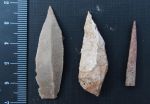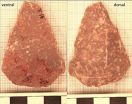The Journal of Human Evolution published a study of the artifacts from Mughr el-Hamamah, or Cave of the Doves, led by Emory University anthropologists Liv Nilsson Stutz and Aaron Jonas Stutz.
"We have achieved remarkably accurate estimates of 40,000 to 45,000 years ago for the earliest Upper Paleolithic stone tools in the Near East," Aaron Stutz says. "Our findings confirm that the Upper Paleolithic began in the region no later than 42,000 years ago, and likely at least 44,600 years ago."
The rich array of artifacts shows a mix of techniques for making points, blades, scrapers and cutting flakes. "These toolmakers appear to have achieved a division of labor that may have been part of an emerging pattern of more organized social structures," Stutz says.
The theory that greater social division of labor was important at this prehistoric juncture was first put forward by anthropologists Steven Kuhn and Mary Stiner.
"Our work really seems to support that idea," Stutz says. "The finds from Mughr el-Hamamah give us a new window onto a transitional time, on the cusp of modern human cultural behaviors, bridging the Middle and Upper Paleolithic."
This pivotal time also marked the ebbing of Neanderthals as a last wave of anatomically modern humans spread out from Africa and into the Near East. This region, also known as the Levant, comprises the eastern Mediterranean at the crossroads of western Asia and northeast Africa. As the final surge of modern humans passed through the Levant, they would likely have encountered human populations that arrived earlier, and they may also have interbred with Neanderthals.
"Our find sits right in the Levantine corridor, midway between the Dead Sea and the Sea of Galilee, where each generation expanding into Eurasia would have foraged for food and made campsites," Stutz says. "We don't know if these toolmakers were mainly Neanderthals or anatomically modern humans, but recent evidence from other studies now raises the possibility that they were a mix of different populations. What we see at the Mughr el-Hamamah site is that individuals were starting to live, work and form families in larger, more culturally structured social networks."
Mughr el-Hamamah is located in a limestone outcrop 240 feet above sea level. It overlooks the Jordan Valley, opposite the Nablus Mountains in the West Bank. The Stutzes, a husband-and-wife team, led excavations of the cave in 2010, funded by a grant from the National Science Foundation.
The relatively undisturbed Upper Paleolithic layer included fireplaces stacked atop one another that yielded chunks of well-preserved charcoal from hearths associated with the tools. Co-authors Jeff Pigati of the U.S. Geological Survey and Jim Wilson of Aeon Laboratories derived radiocarbon dates for the charcoal specimens, using advanced techniques that minimized the chances of contamination.
The cave is about 30-feet deep with an entrance about 20-feet wide. "We can speculate that several families shared the space and worked alongside one another," Aaron Stutz says. "We found burned animal bones, so they were likely roasting meat, and perhaps boiling plants in hides suspended over their fires as they sat nearby making tools. From the mouth of the cave, they would have had a commanding view of what was likely wetlands and open-vegetation terrain. They could see approaching visitors and deer and gazelle wandering in the distance. If their kids were playing outside, they might also be watching for leopards or other predators."
Toolmaking was a major activity of the group, as evidenced by their prolific output. Co-author John Shea, an anthropologist from Stony Brook University and an expert flint knapper himself, is continuing to analyze the thousands of implements they left behind.
Many discoveries of Near Eastern tool assemblages dating prior to the early Upper Paleolithic show that humans focused on just one technology. The tools tend to look similar and likely served many uses - the Stone Age version of a Swiss Army Knife. "It takes a good bit of cleverness to be able to devise a tool that helps you cover lots of different situations," Stutz says. "And it makes sense in a context where you don't necessarily know what you're going to need your piece of flint for that day."
The group of toolmakers at Mughr el-Hamamah, however, used different technologies to get different tools. "They were investing in the kinds of activities that require maintaining relationships and group planning," Stutz says. "They were gearing up for a clearly defined division of labor, including firewood gathering, plant gathering, hunting and food foraging."
They produced large quantities of blades for knives, and for hafting onto spears, using a prismatic blade technique that yields long, narrow points that are nearly identical. "This standardization minimizes waste of the rock while maximizing the end product," Stutz says. "It's the conceptual forerunner to assembly-line production."
Through this method, the toolmakers could have efficiently produced the armature for multiple hunters going out on a lengthy foray, increasing the chances for finding and striking a target, he says.
"It would have been socially advantageous for individuals to give blades that they made to others, to entice them to stay together as a group," he adds. "That kind of reciprocity builds relationships. And the stronger the connectivity of your social networks, the greater chance of increasing the number of calories and the quality of nutrients for the group."
Artifacts from the cave also included scraping tools, made on thick blades for hafting onto a handle and likely used for working wood and animal hides.
Other tools continued to be crafted with what is known as the Levallois technique, which was more often used to make the multi-use flakes and triangular points so common in earlier periods.
Even more surprising, Shea's analysis identified hundreds of basic flakes made from the oldest, easiest Stone Age technology of striking a rock that the toolmaker balances on a stone anvil. These tiny, sharp flakes may have served almost like disposable cutlery - handy implements that could be grabbed for a variety of purposes and tossed aside when no longer needed, Stutz says.
It is not yet known if the few fragments of human bones found at Mughr el-Hamamah have left enough intact fragments of DNA for any genetic analysis. But the diverse tool technologies, in use throughout the occupation period of the cave, support the theory of hunter-gatherer populations starting to band together in larger, more interconnected social networks.
As humans began to dominate the landscape, the researchers theorize, they reached a population density threshold for living in larger groups and gained access to a range of technologies. That process may have helped tip the balance for the rise of modern human culture and the disappearance of the Neanderthals.
"Our findings positively show that the cultural changes associated with Neanderthal extinction in the Near East and wider western Eurasia really are more complex than many leading researchers have assumed," Stutz says. "Instead of looking for a smoking-gun technology or climatic fluctuation or volcanic eruption, it's clear we need to look at interconnected behavioral, population and ecological processes. That approach might reveal more clearly the similarities, as well as differences, between our mainly African, and slightly Neanderthal, biological inheritance."
INFORMATION:
Additional co-authors of the study are: Jason Rech of the University of Miami; Miriam Belmaker of the University of Tulsa; Rosa Maria Alert and Dan Cabanes of the University of Barcelona; Trina Arpin, an independent researcher in Boston; Jaime Clark of the University of Alaska, Fairbanks; Gideon Hartman of the University of Connecticut; Fuad Hourani of the University of Jordan and Chantel White of the University of Notre Dame.


